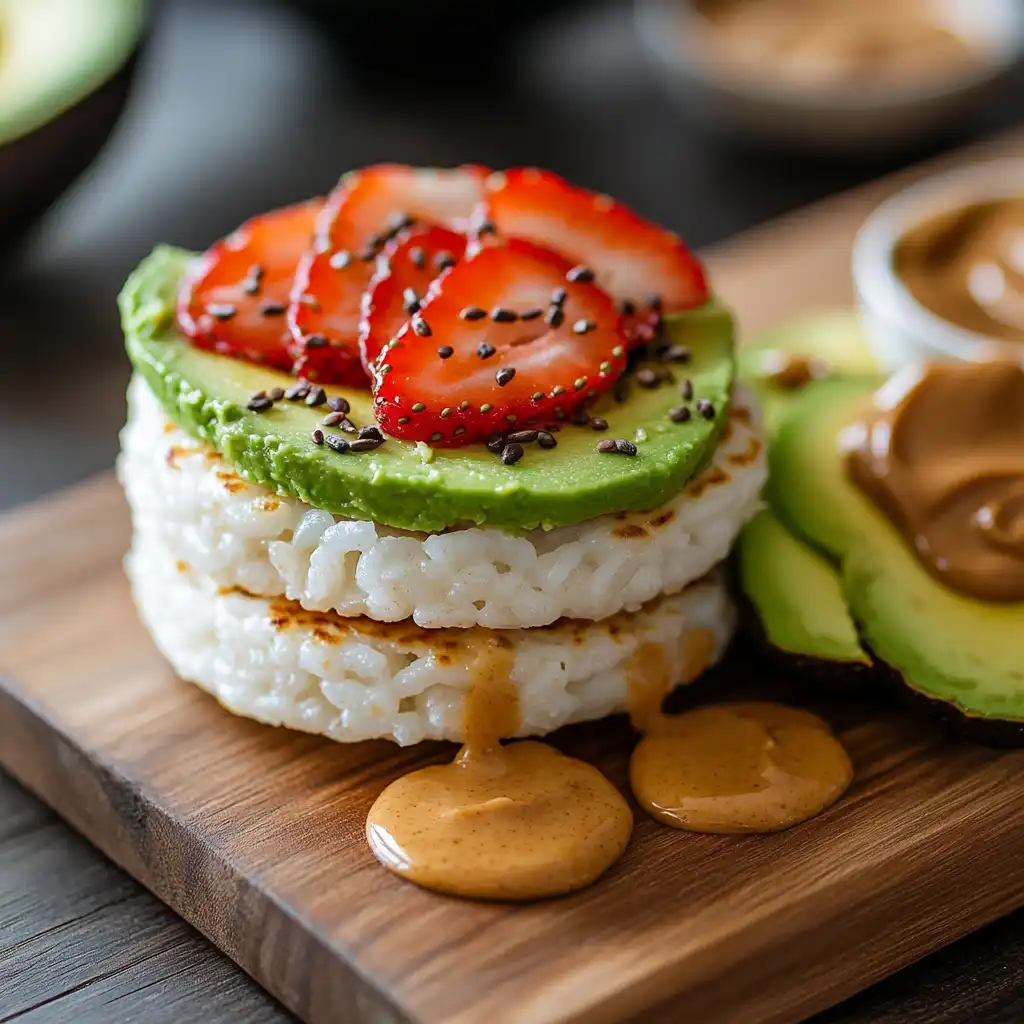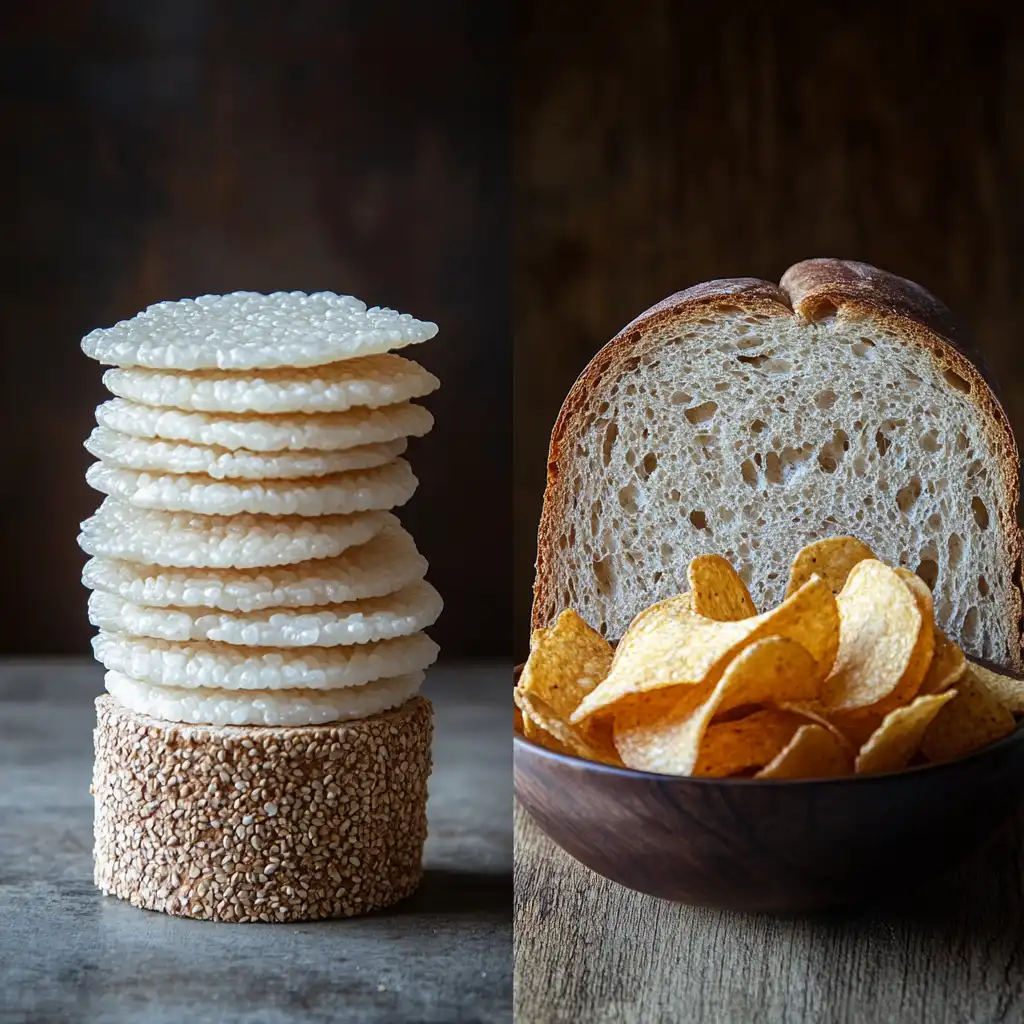
Rice cakes have gained popularity as a light and convenient snack. People often praise them for their simplicity and low calorie content. Their crisp texture and neutral taste make them versatile, allowing easy pairing with sweet or savory toppings.
Many consider rice cakes a healthy choice due to their minimal processing, lack of additives, and association with low-fat diets. However, this reputation raises the question: do they truly deserve their healthy image, or does clever marketing play a role?
Rice cakes hold historical and cultural significance, especially in East Asia, where rice-based snacks have been staples for centuries. Although modern rice cakes differ from traditional versions, they still serve as a simple and satisfying food in many households.
Table of Contents
Nutritional Profile of Rice Cakes
Understanding the health benefits of rice cakes requires an analysis of their nutritional content. Their value depends largely on the specific ingredients and portion sizes.
Calories, Carbohydrates, and Fiber Content
One plain rice cake typically contains 35-60 calories, which appeals to those tracking calorie intake. However, rice cakes primarily consist of carbohydrates, providing 7-15 grams per serving with minimal fiber. This combination often leads to quick digestion, resulting in blood sugar spikes and short-term satiety.
Vitamins and Minerals in Rice Cakes
Plain rice cakes contribute only small amounts of essential vitamins and minerals, such as manganese, selenium, and magnesium. These levels pale in comparison to snacks like nuts or whole-grain crackers. Fortified or flavored varieties may contain more nutrients but often include added sugars, sodium, or artificial flavors.
Comparison to Other Common Snacks
Rice cakes offer some advantages and disadvantages when compared to other snacks:
- Rice Cakes vs. Potato Chips: Rice cakes have lower fat and calorie content, making them a lighter option. However, potato chips often provide more fiber, which increases satiety.
- Rice Cakes vs. Whole-Grain Crackers: Whole-grain crackers generally contain more fiber and nutrients, helping control blood sugar levels and sustain energy.
- Rice Cakes vs. Fruits or Vegetables: Fresh fruits or vegetables deliver significantly more vitamins, minerals, and fiber, making them the superior choice for a nutrient-dense snack.
The Types of Rice Cakes
Rice cakes come in a variety of forms to cater to different preferences and dietary needs. Understanding these options can help you make an informed choice based on your nutritional goals and taste preferences.
Plain vs. Flavored Rice Cakes
Plain rice cakes are the simplest version, made with puffed rice and often containing just one or two ingredients. They have a neutral taste, which makes them an excellent base for toppings like peanut butter, avocado, or cheese. Their minimal ingredients appeal to those seeking a clean, unprocessed snack.
Flavored rice cakes, on the other hand, come in sweet or savory varieties. Popular flavors include chocolate, caramel, cheddar cheese, and barbecue. While these can enhance taste, flavored versions often include added sugars, artificial flavors, or sodium. It’s important to check the label to ensure they align with your dietary preferences.
Organic and Gluten-Free Options
Organic rice cakes are made with rice grown without synthetic pesticides or fertilizers, appealing to those who prioritize organic and non-GMO foods. These versions may also carry certifications that ensure their production meets organic standards.
Gluten-free rice cakes are a staple for individuals with celiac disease or gluten sensitivities. Most rice cakes are naturally gluten-free because rice does not contain gluten. However, it’s still important to confirm this on the label, as cross-contamination can occur during manufacturing.
Variations Across Brands and Countries
Rice cakes vary significantly depending on the brand and region. In Western markets, they are often round, lightweight, and uniform in size. In contrast, some Asian versions, like Korean tteok or Japanese senbei, offer different textures, flavors, and ingredients. These traditional varieties may include added elements like soy sauce, seaweed, or sesame seeds, providing unique cultural and culinary experiences.
The Benefits of Eating Rice Cakes
Rice cakes offer several benefits that make them a popular choice among health-conscious consumers. Their versatility and dietary compatibility contribute to their widespread appeal.
Low-Calorie Snack for Weight Management
One of the most notable advantages of rice cakes is their low calorie content. A single rice cake contains only 35-60 calories, depending on the size and type. This makes them an appealing snack for those aiming to reduce their caloric intake. When combined with healthy toppings, rice cakes can be a satisfying yet calorie-conscious choice.
Gluten-Free Option for Those with Celiac Disease
Rice cakes are naturally gluten-free, making them an excellent alternative for individuals with celiac disease or gluten sensitivities. They provide a safe and convenient snack option for those avoiding wheat and other gluten-containing grains.
Quick and Convenient Food Choice
Rice cakes are incredibly convenient, requiring no preparation or refrigeration. They are portable and lightweight, making them a great option for busy lifestyles. Whether you need a midday snack, a post-workout bite, or a simple vehicle for spreads and toppings, rice cakes fit seamlessly into a variety of eating occasions.
The Downsides of Rice Cakes
While rice cakes have their benefits, they also come with certain drawbacks that are important to consider. Understanding these limitations can help you make more informed decisions about incorporating them into your diet.
High Glycemic Index and Its Implications
One of the primary downsides of rice cakes is their high glycemic index (GI). Foods with a high GI cause rapid spikes in blood sugar levels, which can lead to energy crashes and increased hunger shortly after consumption. This effect may be particularly concerning for individuals managing diabetes or those looking to maintain stable energy levels throughout the day.
Lack of Essential Nutrients
Rice cakes are low in essential nutrients such as protein, healthy fats, and fiber. While they may provide small amounts of carbohydrates, they lack the balanced macronutrient profile needed for sustained energy and overall health. Compared to more nutrient-dense snacks like nuts, seeds, or whole-grain crackers, rice cakes fall short in delivering the vitamins and minerals your body needs.
Additives and Artificial Flavors in Some Varieties
Flavored rice cakes often contain additives such as artificial flavors, sweeteners, and preservatives. These ingredients can detract from the perceived healthiness of rice cakes, especially for those trying to avoid processed foods. Additionally, some flavored varieties are high in sodium or sugar, which may contribute to health issues when consumed in excess.
Are Rice Cakes Filling or Not?
A common critique of rice cakes is their inability to satisfy hunger effectively. Their low calorie and low-nutrient nature can leave people feeling hungry soon after eating. However, there are ways to improve their satiety and make them a more satisfying snack.
Satiety Comparison with Other Snacks
Rice cakes are less filling compared to snacks higher in protein, fiber, or healthy fats. For instance, a handful of almonds or a slice of whole-grain toast provides more sustained energy and keeps hunger at bay longer than a plain rice cake. The quick digestion of rice cakes contributes to their inability to provide long-lasting satiety.
Role of Fiber and Protein in Feeling Full
Fiber and protein play a crucial role in keeping you full. Fiber slows digestion and stabilizes blood sugar levels, while protein supports muscle repair and promotes satiety. Unfortunately, rice cakes are low in both of these nutrients, which limits their ability to stave off hunger effectively.
Strategies to Make Rice Cakes More Satisfying
You can make rice cakes more filling by pairing them with nutrient-dense toppings. Here are some strategies:
- Add Protein: Spread peanut butter, almond butter, or hummus on rice cakes to increase their protein content.
- Incorporate Fiber: Top rice cakes with sliced avocado or a layer of mashed beans for added fiber.
- Combine with Healthy Fats: Add a drizzle of olive oil, a slice of cheese, or some smoked salmon to introduce healthy fats that promote satiety.
By pairing rice cakes with these complementary foods, you can transform them from a light snack into a more balanced and satisfying option.
Are Rice Cakes Good for Weight Loss?
Rice cakes are often associated with weight loss due to their low-calorie nature. However, they lack essential nutrients like protein and fiber, which are crucial for satiety. To make them work for your weight-loss plan, consider pairing them with healthy toppings. For more inspiration, check out Rice Cakes Benefits and Recipes for Healthy Snacking, which includes topping ideas and recipes.
How They Fit Into a Calorie-Controlled Diet
With only 35-60 calories per rice cake, they can easily fit into a calorie-controlled diet. Their low-calorie nature allows you to satisfy a craving without consuming excessive energy. However, because they are primarily carbohydrates with little protein or fiber, they may not keep you full for long. Pairing rice cakes with protein-rich or fiber-dense toppings can make them more suitable for weight loss by increasing satiety.
Are They a Good Alternative to Chips or Bread?
Rice cakes can serve as a better alternative to chips, especially if you’re looking to cut back on fat and calories. They are also lower in calories than most slices of bread, making them a lighter base for spreads and toppings. However, unlike whole-grain bread, rice cakes lack the fiber and nutrients that contribute to sustained energy. Choosing whole-grain rice cakes or pairing them with nutritious toppings can make them a more balanced choice.
Common Misconceptions About Rice Cakes and Dieting
Many people assume that rice cakes are inherently “healthy” or ideal for weight loss simply because they are low in calories. However, eating them in large quantities or relying on them as a primary snack without considering their low nutrient density can hinder weight-loss efforts. Additionally, flavored rice cakes may contain added sugars and sodium, which can counteract their perceived health benefits.
The Role of Rice Cakes in a Balanced Diet
Rice cakes can complement a balanced diet but should not replace more nutrient-dense foods. Their versatility allows for creative combinations, making them a convenient snack when consumed thoughtfully.
Can They Replace Traditional Meals?
Rice cakes are not a suitable replacement for traditional meals, as they lack the protein, healthy fats, and essential nutrients required for a balanced diet. While they may serve as a quick snack or light breakfast base, they should not be relied upon as a substitute for meals like a whole-grain sandwich or a nutrient-rich salad.
Combining Rice Cakes with Nutrient-Dense Foods
To incorporate rice cakes into a balanced diet, pair them with foods that provide protein, fiber, and healthy fats. For example:
- Top with avocado and a sprinkle of seeds for fiber and healthy fats.
- Add cottage cheese and cherry tomatoes for protein and vitamins.
- Use almond butter and banana slices for a satisfying sweet snack.
These combinations enhance the nutritional profile of rice cakes and make them more filling.
Tips for Incorporating Them Healthily
- Limit Flavored Varieties: Choose plain or lightly seasoned rice cakes to avoid excess sugars and sodium.
- Practice Portion Control: Stick to a reasonable serving size to prevent overindulging.
- Use as a Complement, Not a Staple: Incorporate rice cakes alongside whole, nutrient-dense foods rather than making them a primary food source.
Are Flavored Rice Cakes Healthy?
Flavored rice cakes offer a tasty twist on the traditional plain variety, but their healthiness varies based on the ingredients used. It’s essential to examine their labels before including them in your diet.
Added Sugars and Artificial Ingredients
Many flavored rice cakes contain added sugars and artificial flavors, particularly in sweet varieties like caramel or chocolate. These additives increase the calorie count and detract from their reputation as a healthy snack. Opt for minimally flavored options or stick to plain rice cakes if you aim to avoid these ingredients.
Sodium Levels in Flavored Options
Savory flavored rice cakes, such as cheddar or barbecue, can be high in sodium. Excessive sodium intake may contribute to high blood pressure and other health concerns. Check the nutritional label for sodium content and limit consumption of heavily seasoned varieties.
Healthier Flavored Rice Cake Alternatives
For a healthier option, choose rice cakes that use natural seasonings or minimal added ingredients. Some brands offer varieties flavored with herbs, spices, or natural sweeteners like honey. Alternatively, create your own flavored rice cakes by adding wholesome toppings, such as:
- A drizzle of natural peanut butter and a sprinkle of cinnamon.
- A thin layer of hummus with cucumber slices and cracked pepper.
- A smear of yogurt topped with fresh berries.
The Science Behind the Glycemic Index
Understanding the glycemic index of rice cakes is key to managing their impact on blood sugar levels. Pairing rice cakes with low-GI foods can help mitigate their effects. For tips on pairing foods effectively, our article on The Ultimate Guide to the Perfect Beef Tips Recipe provides great ideas for balancing meals.
What Is the Glycemic Index?
The glycemic index ranks foods on a scale from 0 to 100 based on how quickly they raise blood sugar levels. Foods with a high GI (70 or above) cause rapid spikes in blood sugar, while those with a low GI (55 or below) result in slower, steadier increases. Foods with a moderate GI fall in between these two categories.
Rice cakes typically have a high GI, with values ranging from 70 to 90 depending on the type and ingredients. This means they digest quickly, providing a quick energy boost but also leading to potential energy crashes soon after.
How Rice Cakes Affect Blood Sugar Levels
Due to their high GI, rice cakes cause blood sugar levels to rise rapidly. This can be problematic for individuals with diabetes or those seeking to maintain stable energy levels. The quick release of glucose into the bloodstream may lead to an insulin spike, followed by a drop in blood sugar that can leave you feeling hungry again.
Managing Glycemic Load with Rice Cakes
The glycemic load (GL) takes portion size into account, offering a more practical measure of a food’s impact on blood sugar. While rice cakes alone have a high GI, pairing them with low-GI foods like avocado, nut butter, or hummus can reduce their overall glycemic load. This approach helps balance blood sugar levels and increases satiety.
Rice Cakes for Special Diets
Rice cakes are versatile and can fit into various dietary patterns. However, their suitability depends on the specific guidelines of each diet.
Vegan and Vegetarian Suitability
Rice cakes are inherently plant-based, making them suitable for both vegan and vegetarian diets. They serve as a neutral canvas for plant-based toppings like hummus, almond butter, or fruit slices, enhancing their nutritional value.
Compatibility with Keto and Low-Carb Diets
Rice cakes are not ideal for keto or strict low-carb diets because they are primarily made of carbohydrates. A single rice cake can contain 7-15 grams of carbs, which may be too high for individuals adhering to the carbohydrate restrictions of these diets. Instead, low-carb alternatives like almond flour crackers or vegetable slices may be more appropriate.
Alternatives for Paleo and Whole Food Diets
Traditional rice cakes may not align with paleo or whole food diets, which often exclude processed foods. However, some brands offer paleo-friendly rice cakes made with sprouted or minimally processed ingredients. Alternatively, snacks like roasted sweet potato slices, coconut chips, or homemade vegetable crisps can serve as better options for those following these diets.
Comparing Rice Cakes with Other Snacks
Rice cakes can be a lighter alternative to bread or chips, but their high glycemic index can lead to blood sugar spikes. If you’re seeking alternatives, The Ultimate Guide to Shaved Beef Recipes offers insights into high-protein snacks that pair well with lighter carbs for balanced nutrition.

Chips vs. Rice Cakes: Which Is Healthier?
- Calories and Fat: Rice cakes are lower in calories and fat compared to most chips, making them a lighter option.
- Nutrients: Chips may contain more fiber and protein, depending on the variety, which can enhance satiety. However, they are often higher in sodium and unhealthy fats.
- Verdict: Rice cakes are healthier for those seeking a low-calorie, low-fat snack, while chips may be more filling but less nutritious.
Rice Cakes vs. Whole-Grain Bread
- Calories: A single rice cake contains fewer calories than a slice of whole-grain bread, making it suitable for calorie-conscious individuals.
- Nutrients: Whole-grain bread is richer in fiber, protein, and essential nutrients, making it a more balanced option.
- Verdict: Whole-grain bread is better for sustained energy and overall nutrition, while rice cakes are a convenient low-calorie alternative.
Nutritional Pros and Cons of Similar Snacks
- Popcorn: Like rice cakes, popcorn is low in calories and fat. However, air-popped popcorn offers more fiber, making it a more filling choice.
- Crackers: Whole-grain crackers provide more fiber and protein than rice cakes but are usually higher in calories.
- Vegetable Chips: These can be nutrient-dense if baked or minimally processed but may also be high in fat and sodium.
Are Rice Cakes Safe for Children?
Rice cakes are often considered a convenient snack for children due to their simplicity and ease of handling. However, parents should evaluate their nutritional benefits and potential risks before including them in a child’s diet.
Nutritional Benefits for Kids
Rice cakes are low in calories and free of common allergens like gluten, making them a safe option for many children. They can serve as a quick, easy snack or a base for nutrient-dense toppings. For instance, adding spreads like peanut butter or hummus can increase protein and healthy fat intake, while topping with fruits or vegetables can boost fiber and vitamins.
Risks of Choking or Insufficient Nutrition
For younger children, especially toddlers, rice cakes can pose a choking hazard due to their hard and crunchy texture. Parents should monitor children closely while they eat or break the rice cakes into smaller pieces to minimize this risk.
Nutritionally, plain rice cakes lack essential nutrients like protein, fats, and fiber, which are critical for a growing child. Over-reliance on rice cakes as a snack may lead to insufficient nutrient intake. To mitigate this, rice cakes should be paired with more nutrient-dense foods.
Creative Ways to Serve Rice Cakes to Children
Making rice cakes more appealing and nutritious for kids can be both fun and easy. Here are some ideas:

- Sweet Toppings: Spread nut or seed butter on a rice cake and top with banana slices, a drizzle of honey, or a sprinkle of cinnamon.
- Savory Options: Add mashed avocado with a sprinkle of salt or a slice of cheese and cherry tomatoes.
- Mini Pizzas: Use rice cakes as a base, add tomato sauce, shredded cheese, and diced vegetables, then lightly warm them.
- Fun Shapes: Break rice cakes into fun shapes or smaller pieces that are easier for children to handle.
Expert Opinions on Rice Cakes
Rice cakes receive mixed reviews from health professionals, as their suitability depends on individual dietary goals and how they are incorporated into a meal plan.
What Nutritionists Say About Rice Cakes
Nutritionists often point out that rice cakes are a low-calorie and allergen-friendly snack. However, they emphasize that rice cakes are not nutrient-dense and should not replace whole foods rich in protein, fiber, and healthy fats. Nutritionists generally recommend enhancing rice cakes with nutritious toppings to improve their overall value.
Fitness Experts’ Take on Using Rice Cakes for Weight Loss
Fitness experts commonly suggest rice cakes as a post-workout snack or a low-calorie option for those seeking to lose weight. They highlight that rice cakes can provide quick-digesting carbohydrates to replenish energy after exercise. However, they also stress the importance of pairing rice cakes with protein-rich foods to aid in muscle recovery and sustain energy.
Recommendations from Dietitians
Dietitians recommend rice cakes in moderation as part of a balanced diet. They advise choosing plain or whole-grain varieties over flavored options to avoid added sugars and sodium. Dietitians also suggest pairing rice cakes with nutrient-dense foods like lean proteins, healthy fats, and fiber-rich toppings to improve satiety and nutritional balance.
FAQs About Rice Cakes
Can Rice Cakes Be Part of a Diabetic-Friendly Diet?
Rice cakes can be included in a diabetic-friendly diet, but with caution. Due to their high glycemic index (GI), plain rice cakes can cause spikes in blood sugar levels. To make them more suitable, pair rice cakes with low-GI foods like avocado, nut butter, or hummus, which help slow glucose absorption. Choosing whole-grain rice cakes can also lower their glycemic impact.
Are Rice Cakes Healthier Than Bread?
Rice cakes are lower in calories compared to most types of bread, which may appeal to those seeking a lighter snack. However, whole-grain bread offers more fiber, protein, and nutrients, making it a better choice for sustained energy and satiety. Rice cakes can serve as a lighter alternative but lack the balanced nutrition provided by whole-grain bread.
How Many Rice Cakes Can You Eat in a Day?
The number of rice cakes you can eat in a day depends on your overall calorie and carbohydrate needs. For most people, 1-3 rice cakes paired with nutrient-dense toppings are sufficient as a snack. Overeating rice cakes, especially flavored varieties, can lead to excessive carbohydrate intake without providing significant nutritional value.
Can Rice Cakes Help With Digestion?
Rice cakes are low in fiber, so they don’t directly promote digestion. However, they are easy to digest and can be a suitable option for individuals with sensitive stomachs or digestive issues. To improve digestive health, pair rice cakes with high-fiber foods like fruits, vegetables, or seeds.
Are Rice Cakes a Good Pre-Workout Snack?
Rice cakes can be a good pre-workout snack because they provide quick-digesting carbohydrates that offer an immediate energy boost. To enhance their effectiveness, combine rice cakes with a small amount of protein or healthy fat, such as almond butter or Greek yogurt, for sustained energy throughout your workout.
What Are the Healthiest Brands of Rice Cakes?
Some of the healthiest rice cake brands offer whole-grain or minimally processed options without added sugars or artificial ingredients. Examples include:
- Lundberg Family Farms: Known for their organic and whole-grain rice cakes.
- Quaker: Offers plain and lightly salted varieties with simple ingredients.
- Kallo: Provides whole-grain and organic options with natural flavors.
- Simple Truth Organic: Features low-sodium and gluten-free rice cakes.
When choosing a brand, look for labels indicating whole-grain ingredients, low sodium, and minimal added sugars.
